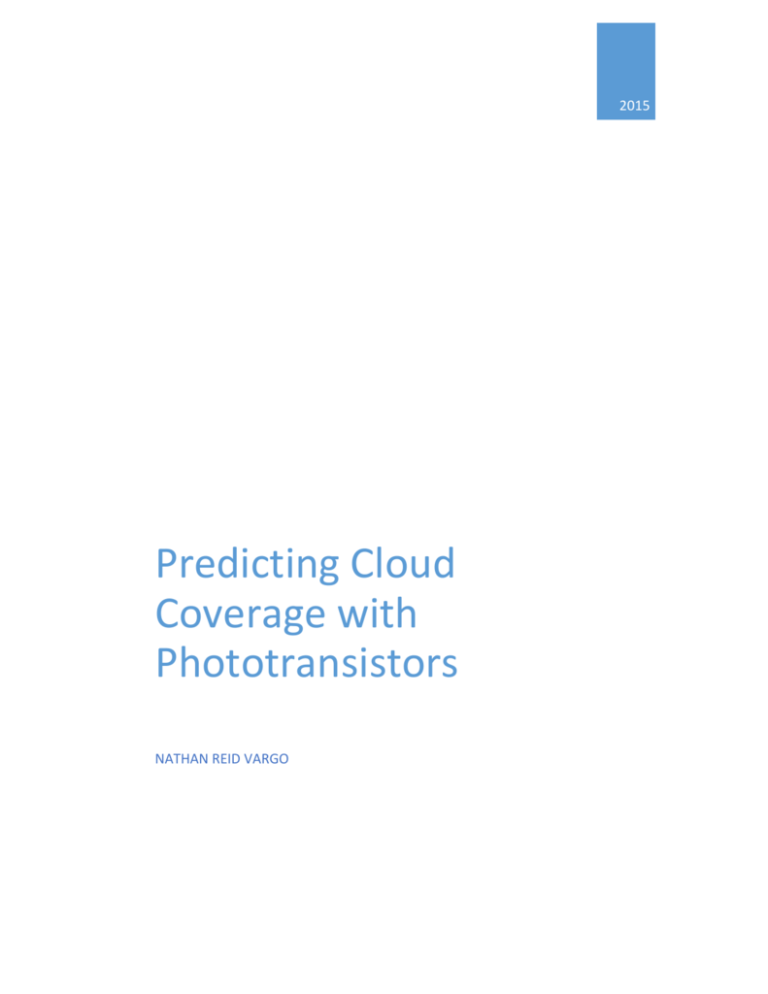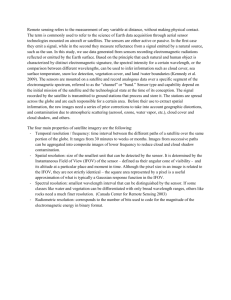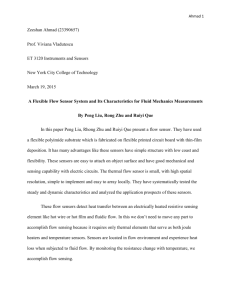Predicting Cloud Coverage with Phototransistors
advertisement

2015 Predicting Cloud Coverage with Phototransistors NATHAN REID VARGO Keywords Sensor: Phototransistor: Rail Voltage: IDE: String Data: UI: Small device to transduce a physical signal into an electrical signal A transistor that passes more volts depending on ambient light The power supply voltage for the circuit Integrated Development Environment Data stored in the format of a string User Interface 1 Abstract This paper will demonstrate that cloud coverage can be accurately and cheaply predicted using simple phototransistors. Each ‘sensor’ (a phototransistor connected to a small circuit) needs to be placed a certain distance away from the area one wishes to predict cloud cover. The increase in distance gives more warning time, but also greater possible error in predictions. The more sensors being used, the more accurate the prediction can be. As long as sensors are placed in areas that are not covered by trees, powerlines, etc. the drop in sunlight can be assumed to be from the clouds crossing the horizon. These sensors, however, do need to be placed in areas that have a Wi-Fi connection so that it can be possible to communicate easily from any distance. These sensors have a small microcontroller connected to them to send and display data to an online web server. Once online, the main program simply needs to poll for this data and make predictions using an algorithm developed to give an approximation of the time the area being protected will be covered by a cloud. The details of this application of phototransistors will be further explained below. 2 Introduction The need for predicting cloud coverage is fairly new since the rise and popularity of solar panel devices. These devices can transduce ambient sunlight into a form of electrical power. This energy is clean and does not produce waste products (CO2) like fossil fuels. This idea of clean energy is huge nowadays considering all the scientific data showing a man-made greenhouse effect with the increase of CO2 in the atmosphere. Also, since sunlight is all over Earth, once everything is set up, power is free so long as there are no issues with the transduction. One of the main issues that can be seen right away is the clouds. Clouds can cover the sunlight and drop power output down as low as 10% of the output on a sunny day. Since this is a huge concern, it would be nice to know when the clouds will cover an existing solar panel array. The design presented is a system of sensors that can be used to accurately predict when an array of solar panels will be covered by clouds and the approximate power drop associated with the cover. 3 Overview The following Figure shows a simple diagram of the system. A house is being used to demonstrate any area that has Wi-Fi accessibility. From this point, the sensor wirelessly uploads data onto a webserver which the program developed can request the data and process it. Figure 1: Simple diagram of system This Figure is also only shows one sensor. The actual system has multiple sensors that obtain and upload data from many locations. This is what makes accurate predictions possible with a very small (negligible) delay. The system can be split up into three sections: the sensors, communication, and processing. The sensors are used to transduce physical signals into electrical ones. The communication part sends these signals to the microcontroller to output the data received to a webserver. Lastly, processing the data refers to the program being used to calculate a prediction of cover and power drop. 4 Advance Information The following information delves deeply into design and how each stage of the system is used in calculating the final output (time of cover and power drop). Sensors The sensor (black box on house in Figure 1) has a small circuit that is used to power it. This circuit can be seen in Figure 2. Figure 2: Circuit to power phototransistor This simple circuit allows the output to be variable from the ground voltage to the rail voltage (5V in this circuit diagram). The more sunlight available, the more the transistor will be ‘on’ (becomes more like a short circuit). This passes a maximal voltage at maximum sunlight. Also, the size of the resistors can be adjusted to reduce current flow if that is an issue. Communication The method of communication used in this application is Wi-Fi. This allows for the sensors to be anywhere as long as there is a Wi-Fi connection. This is realized through the microcontroller “Electric IMP002”. This microcontroller has wireless capability built in and can be set up with ease to get data online. Figure 3 shows a block diagram of the IMP002. The microcontroller has an online IDE to program so it can be programmed from any computer with access to the internet. It also comes with a storage webserver for uploading string files online. Figure 4 shows the diagram for Wi-Fi communication. Figure 3: Block diagram of IMP002 5 Figure 4: Communication diagram using IMP002 Once the data is online, the program created in Microsoft Visual Studio can obtain the data and further process it down. Processing The processing of the data is using a family of algorithms to decide when the cloud will hit. It also calculates power drop, direction, and distinguishes between an actual cloud and some ‘noise’ (i.e. a bird). Figure 5 shows the UI of the program and the sensors. A map of MSU campus and its’ outskirts to place sensors down in corresponding actual locations. The amount of sensors is arbitrary and can be in any arrangement. Also, the solar panel can be moved as easily as the sensors with the click-and-drag method. Figure 5: UI of program Since everything is created with Visual studio, any computer with Visual Studio will be able to run the software package being used. 6 Conclusions The phototransistor is shown to be able to predict possible weather fronts for hitting a certain area of the user’s decision so long as there is an array of them. The array does not need to be in any specific shape. Once set up, the data can be easily transferred over Wi-Fi to be available for processing. With this approach it is noted that each sensor will be required to have an enclosure to endure the harsh conditions that the atmosphere may bring all while still allowing the phototransistor to have a good field of detection. Also, the more sensors that are obtained and placed, the more accurate a prediction will be. With the enclosure issue solved, the phototransistor is shown to have a good application in predicting cloud forms. References https://www.electricimp.com/docs/attachments/hardware/product%20briefs/Electric%20I mp%20-%20imp002%20-%20Product%20Brief%20-%2022Jun2015.pdf 7







